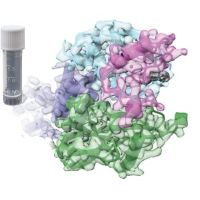Specification
| Description | Recombinant protein from the full-length sequence of Homo sapiens endoplasmic reticulum oxidoreductase 1 beta (ERO1B) (NM_019891). |
| Organism | Homo sapiens (Human) |
| Expression Host | Human Cells |
| Tag Info | His or DYKDDDDK. Please contact us if you need further information or require specific designed tag. |
| Purity | Greater than 90% by SDS-PAGE gel |
| Uniprot ID | Q86YB8 |
| Entry Name | ERO1B_HUMAN |
| Gene Names | ERO1B ERO1LB |
| Alternative Gene Names | ERO1LB |
| Alternative Protein Names | ERO1-like protein beta (ERO1-L-beta) (EC 1.8.4.-) (Endoplasmic reticulum oxidoreductase beta) (Endoplasmic reticulum oxidoreductin-1-like protein B) (Oxidoreductin-1-L-beta) |
| Application | Antigens, Western, ELISA and other in vitro binding or in vivo functional assays, and protein-protein interaction studies; For research & development use only! |
| Buffer | Purified protein formulated in a sterile solution of PBS buffer, pH7.2, without any preservatives |
| Endotoxin | Endotoxin level is < 0.1 ng/µg of protein (<1EU /µg) |
| Length | 467 |
| Molecular Weight(Da) | 53543 |
| Protein Sequence | (The sequence of expressed protein may have some variation from the sequence shown below. Please contact us for the exact sequence.) MSQGVRRAGAGQGVAAAVQLLVTLSFLRSVVEAQVTGVLDDCLCDIDSIDNFNTYKIFPKIKKLQERDYFRYYKVNLKRPCPFWAEDGHCSIKDCHVEPCPESKIPVGIKAGHSNKYLKMANNTKELEDCEQANKLGAINSTLSNQSKEAFIDWARYDDSRDHFCELDDERSPAAQYVDLLLNPERYTGYKGTSAWRVWNSIYEENCFKPRSVYRPLNPLAPSRGEDDGESFYTWLEGLCLEKRVFYKLISGLHASINLHLCANYLLEETWGKPSWGPNIKEFKHRFDPVETKGEGPRRLKNLYFLYLIELRALSKVAPYFERSIVDLYTGNAEEDADTKTLLLNIFQDTKSFPMHFDEKSMFAGDKKGAKSLKEEFRLHFKNISRIMDCVGCDKCRLWGKLQTQGLGTALKILFSEKEIQKLPENSPSKGFQLTRQEIVALLNAFGRLSTSIRDLQNFKVLLQHSR |
Background
| Function | FUNCTION: Oxidoreductase involved in disulfide bond formation in the endoplasmic reticulum. Efficiently reoxidizes P4HB/PDI, the enzyme catalyzing protein disulfide formation, in order to allow P4HB to sustain additional rounds of disulfide formation. Other protein disulfide isomerase family members can also be reoxidized, but at lower rates compared to P4HB, including PDIA2 (50% of P4HB reoxidation rate), as well as PDIA3, PDIA4, PDIA6 and NXNDC12 (<10%). Following P4HB reoxidation, passes its electrons to molecular oxygen via FAD, leading to the production of reactive oxygen species (ROS) in the cell. May be involved in oxidative proinsulin folding in pancreatic cells, hence may play a role in glucose homeostasis. {ECO:0000269|PubMed:11707400, ECO:0000269|PubMed:21091435}. |
| Pathway | |
| Protein Families | EROs family |
| Tissue Specificity | Highly expressed in the digestive tract, including the duodenum and lower digestive tract. In the stomach, highly expressed in enzyme-producing chief cells (at protein level). In the pancreas, expressed in islets of Langerhans and, at lower levels, in enzyme-secreting cells (at protein level). Detected at low level in many other tissues. {ECO:0000269|PubMed:10818100, ECO:0000269|PubMed:16012172}. |
QC Data
| Note | Please contact us for QC Data |
| Product Image (Reference Only) |  |

